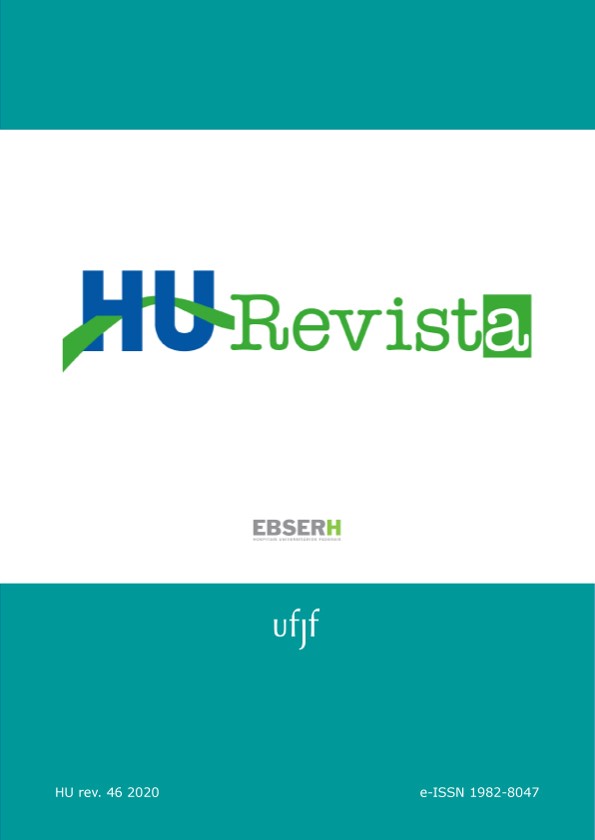Frantz's tumor, a diagnostic challenge: case report
DOI:
https://doi.org/10.34019/1982-8047.2020.v46.29025Keywords:
Pancreatic Neoplasms, Duodenal Ulcer, AnemiaAbstract
Introduction: Pseudopapillary solid pancreatic tumor (Frantz's tumor) is a solid-cystic exocrine cell neoplasm that accounts for about 0.2-2.7% of all pancreatic tumors. It is a rare disease with low potential for malignancy, preferentially affecting young women, with an average age of 25 years. Complete surgical resection of the lesion is the treatment of choice, and the prognosis is excellent. Objective: To report a challenging case of Frantz's tumor with atypical clinical-radiological presentation, in which imaging exams were fundamental for the diagnostic elucidation and therapeutic management. Case Report: 31-year-old female patient with chronic anemia, hematemesis, melena and hematochezia. Upper gastrointestinal endoscopy showed an active ulcer in the duodenal bulb. Tomography revealed an expansive mass located between the pancreatic head and the duodenum, with signs of ulceration. At this time, the main diagnostic hypotheses were gastrointestinal stromal tumor (GIST) or Frantz tumor. Magnetic resonance imaging characterized an intimate relationship of the lesion with pancreatic tissue, making the diagnosis of Frantz tumor as the best hypothesis. Then, the patient was submitted to total duodenopancreatectomy for resection and definitive treatment of the lesion. Immunohistochemistry revealed cells with indistinct eosinophilic cytoplasm and hyperchromatic nuclei, sometimes with pseudopapillary arrays, as well as expression for beta-catenin in nuclear pattern and positivity for CD10 and CD99, confirming that it is a solid pseudopapillary tumor of the pancreas. Conclusion: The importance of imaging tests for characterization and assertive diagnosis is observed of this type of tumor, allowing the complete lesion resection and perspective of cure.
Downloads
References
Papavramidis T, Papavramidis S. Solid pseudopapillary tumors of the pancreas: review of 718 patients reported in English literature. J Am Coll Surg. 2005; 200(6):965-72.
Słowik-Moczydłowska Z, Gogolewski M, Yaqoub S, Piotrowska A, Kamiński, A. Solid pseudopapillary tumor of the pancreas (Frantz’s tumor): two case reports and a review of the literature. J Med Case Rep. 2015; 9:268.
Buetow PC, Buck JL, Pantongrag-Brown L, Beck KG, Ros PR, Adair CF. Solid and papillary epithelial neoplasm of the pancreas: imaging-pathologic correlation on 56 cases. Radiology 1996; 199(3):707-11.
Al-Qahtani S, Gudinchet F, Laswed T, Schnyder P, Schmidt S, Osterheld MC et al. Solid pseudopapillary tumor of the pancreas in children: typical radiological findings and pathological correlation. Clin Imaging. 2010; 34(2):152-6.
Coelho JCU, Valle CL, Ribas BM, Andriguetto LD, Claus CMP. Surgical treatment of cystic neoplasms of the pancreas. Arq Ggastroenterol. 2010; 47:135-40.
Resende V, Braga CA, Garcia EC. Pancreatectomia distal com preservação do baço em tumor sólido pseudopapilar do pâncreas (tumor de Frantz): relato de caso. Rev Med Minas Gerais. 2011; 21:218-22.
Costa-Neto GD, Amico EC, Costa GID. Tumor sólido-cístico pseudopapilar do pâncreas (tumor de Frantz): estudo de quatro casos. Arq Gastroenterol. 2004; 41:259-62.
Frantz VK. Tumors of the pancreas. In: Armed Forces Institute of Pathology. Atlas of tumor pathology. Washington (DC): Armed Forces Institute of Pathology; 1959. Section VII, Fascicles 27 and 28.
Costa SRP, Henriques AC, Godinho CA, Miotto MJ, Costas MC, Horta SH et al. Pancreatic solid-cystic papillary tumor: clinical aspects, radiological findings and surgical treatment in a series of five patients. Einstein. 2007; 5:161-5.
Vollmer CM Jr, Dixon E, Grant DR. Management of a solid pseudopapillary tumor of the pancreas with liver metastases. HPB. 2003; 5:264-7.
Machado MC, Monteiro da Cunha JE, Bacchella T, Jukemura J, Penteado S, Zerbini MCN et al. Tumor de Frantz (neoplasia epitelial papilar e cistica do pancreas): estudo de tres casos report of 3 cases. Rev Hosp Clin Fac Med Sao Paulo. 1993; 48:29-34.
Pereira Jr. GA, Stracieri LDS, Espada PC, Andrade JI, Ceneviva R. Neoplasia papilar cístico-sólida de pâncreas. Rev Col Bras Cir. 1998; 25:351-3.
Mao C, Guvendi M, Domenico D, Kim K, Thomford NR, Howard JM. Papillary cystic and solid tumors of the pancreas: a pancreatic embryonic tumor? Studies of three cases and a cumulative review of the world’s literature. Surgery. 1995; 118:821-8.
Pinto Jr. FEL, Moraes MV, Oliveira AGF. Neoplasia papilar cística do pâncreas. Rev Col Bras Cir. 2001; 28:304-6.
Jakhlal N, Njoumi N, Hachi H, Bougtab A. [Solid pseudopapillary tumour of the pancreas: about a case and review of the literature]. Pan Afr Med J. 2016; 24:104.
Partezani AD, Mattar GG, Zatz RF, Ijichi TR, Moricz A, De Campos T et al. Tumor de Frantz: um caso raro com características não habituais. Arq Med Hosp Fac Cienc Med Santa Casa São Paulo. 2013; 58(1):46-9.
Downloads
Published
How to Cite
Issue
Section
License
Cessão de Primeira Publicação à HU Revista
Os autores mantém todos os direitos autorais sobre a publicação, sem restrições, e concedem à HU Revista o direito de primeira publicação, com o trabalho licenciado sob a Licença Creative Commons Attribution que permite o compartilhamento irrestrito do trabalho, com reconhecimento da autoria e crédito pela citação de publicação inicial nesta revista, referenciando inclusive seu DOI.









